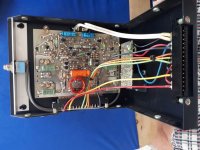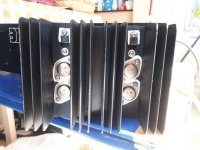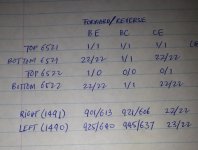I have an old Bryston 3B pro with blown fuse on the right channel 🙁 .What I did:
1/ Replaced 5A fast acting, plug in with light bulb limiter, bulb lit up bright.
2/ Removed right channel module, plug in, bulb dim.
I intend to check the BR6522/ BR6521 and SJE1490/ SJE1491 but I am not really sure how to remove them for checking.
My questions: (I am a beginner, bare with me please.)
1/ Is there any way to check them without remove from circuit (I think less likely)
2/ If not then these steps I would want to take:
- Desoldering all 6 transistors.
- Remove 8 screws which attached transistors to heat sink
- Remove 8 screws which attached metal case to heat sink.
Let me know if these are the right way or any thing I am better watch out as beginner may miss.
Thanks,
Troy
1/ Replaced 5A fast acting, plug in with light bulb limiter, bulb lit up bright.
2/ Removed right channel module, plug in, bulb dim.
I intend to check the BR6522/ BR6521 and SJE1490/ SJE1491 but I am not really sure how to remove them for checking.
My questions: (I am a beginner, bare with me please.)
1/ Is there any way to check them without remove from circuit (I think less likely)
2/ If not then these steps I would want to take:
- Desoldering all 6 transistors.
- Remove 8 screws which attached transistors to heat sink
- Remove 8 screws which attached metal case to heat sink.
Let me know if these are the right way or any thing I am better watch out as beginner may miss.
Thanks,
Troy
Attachments
Check with the tester between metal can the two pins for a short. mj15003/4 are the replacement .
In principle measure them mounted, on the diode scale: BE , BC, CE, both ways, 6 measurements total per transistor.
We are starting with the most crude measurements, searching for dead shorts.
Mounted or not, nothing hides a short.
Post any shorts found.
Lots more to measure, but that´s the beginning.
We are starting with the most crude measurements, searching for dead shorts.
Mounted or not, nothing hides a short.
Post any shorts found.
Lots more to measure, but that´s the beginning.
You might start with the screws securing the TO-3's -- I've been inside older model 2B, 3B, and 4B's so yours may be different. But generally, since TO-3's may be socketed, it's worth making sure they won't just hop right out for you! 😉
Good Luck
edit: The challenge of comparing channels on Brystons is that they're modular -- designed to be field-repairable by popping in a replacement module. Everything disconnects as you open it. A nice set of jumpers would be a miracle.
Good Luck
edit: The challenge of comparing channels on Brystons is that they're modular -- designed to be field-repairable by popping in a replacement module. Everything disconnects as you open it. A nice set of jumpers would be a miracle.
Last edited:
Thank you all for your quick replies. I will measure them then let you know.
Rick, "TO-3's" what is that? Are you refer to SJE1490/ SJE1491 (are they also call drivers, as I try to learn terminology LOL). I don't see any socket, just solder to PCB.
Rick, "TO-3's" what is that? Are you refer to SJE1490/ SJE1491 (are they also call drivers, as I try to learn terminology LOL). I don't see any socket, just solder to PCB.
Those are the diamond-shaped housings (2 screws each) showing in your OP, 2nd picture -- the BR6521 and BR6522 parts; those are the output transistors.
The word 'driver' usually indicates the previous transistor or two. Those provide the current gain to get from 'large-swing signal level', to the much higher current needed to move an 8 or 4 ohm speaker load.
If your DMM has a Diode range, JMFahey's recommendation in post #3 is spot on.
Regards
The word 'driver' usually indicates the previous transistor or two. Those provide the current gain to get from 'large-swing signal level', to the much higher current needed to move an 8 or 4 ohm speaker load.
If your DMM has a Diode range, JMFahey's recommendation in post #3 is spot on.
Regards
Last edited:
Ask Bryston for the pair of output transistors with your serial number.No need of changing all the channel .( Bryston dixit).Minimal DC on your preamp or pluging first your amp ......
Cut a cheap screwdriver and with a bit of patience file the metal to get the square and you have the Bryston tool.
sorry for my ignorance,
1/ which pair of output transistors I should ask for (top 6521& top 6522)?
2/ Bryston tool? please explain as I don't know what it for
Thanks
1/ which pair of output transistors I should ask for (top 6521& top 6522)?
2/ Bryston tool? please explain as I don't know what it for
Thanks
1/ which pair of output transistors I should ask for (top 6521& top 6522)?
2/ Bryston tool? please explain as I don't know what it for
1/ MJ15003/4 I recommend replacing all 4 output transistors in the bad channel at the same time.
2/ The Robertson screw driver is a superior design to flat and phillips types and was invented in Canada:
History of the Robertson Screwdriver.
Take care,
Doug
oh OK, just call square head, "Robertson", learn something new everyday. thanks.
Questions:
1/ Are the 2 top 6521/6522 with all reading 0 and 1 are bad? (for learning)
2/ From the reading, are my TO-220 transistors SJE1490/ 1491 still good? if not I can order and replace at once.
3/ Equivalent (BR6521 with MJ15003) and (BR6522 with MJ15004). Brand specific?
4/ Do I need to replace on the good channel also with 1503/1504? any advantage?
5/ Should I replace the thin (insulator?) and put thermal paste on new transistors? I don't know if they come with transistors as I never order.
6/ Sorry for asking so many questions LOL
Questions:
1/ Are the 2 top 6521/6522 with all reading 0 and 1 are bad? (for learning)
2/ From the reading, are my TO-220 transistors SJE1490/ 1491 still good? if not I can order and replace at once.
3/ Equivalent (BR6521 with MJ15003) and (BR6522 with MJ15004). Brand specific?
4/ Do I need to replace on the good channel also with 1503/1504? any advantage?
5/ Should I replace the thin (insulator?) and put thermal paste on new transistors? I don't know if they come with transistors as I never order.
6/ Sorry for asking so many questions LOL
Don't be sorry, these are all valid questions.
1/ Yes the top two are probably bad. Sometimes another bad part close by in the circuit can make a good part measure bad, the final proof is testing the transistors out of circuit.
2/ I can't say for sure if they are bad or not. Testing them out of circuit would tell you for sure. If they are not expensive you could just go ahead and replace them.
3/ ON Semiconductor? Make sure that you get them from a reputable source.
4/ I always replace all of the output transistors in both channels when an older amplifier has one channel fail. In my experience the other channel isn't far behind. Also, for some reason I find that it's the right channel that usually fails first in an amplifier.
5/ Yes you need thermal paste and insulators. You can probably reuse the old insulators if you carefully clean them off first.
Take care,
Doug
1/ Yes the top two are probably bad. Sometimes another bad part close by in the circuit can make a good part measure bad, the final proof is testing the transistors out of circuit.
2/ I can't say for sure if they are bad or not. Testing them out of circuit would tell you for sure. If they are not expensive you could just go ahead and replace them.
3/ ON Semiconductor? Make sure that you get them from a reputable source.
4/ I always replace all of the output transistors in both channels when an older amplifier has one channel fail. In my experience the other channel isn't far behind. Also, for some reason I find that it's the right channel that usually fails first in an amplifier.
5/ Yes you need thermal paste and insulators. You can probably reuse the old insulators if you carefully clean them off first.
Take care,
Doug
Last edited:
R-10 Vaco is the only thing I've ever known them as. Wish it hadn't taken the development of cold-heading for it to have really taken off.
I'm a little puzzled by some of the measurements in post #8. The outputs are definitely all toast. Are these millivolts on a diode range, or ohms? The SJE1490/91 might be OK, IF your meter flips polarity when it performs whatever test that was you listed (many older meters did). But 600-ish millivolts one way and 900-ish the other is still pretty suspicious.
These are good questions. No need to apologize.😉
1/ Yes. Dead, dead, dead, and dead.
2/ Possibly. If exact replacement available, buy them; or if a decent sub is, at a decent price, buy them.
3/ Those cute little stylized 'M's are Motorola. Still makes me sad they're gone.
4/ No. And if you need a good reason, keep it original so you have a working-known-good reference to measure.
5/ Opinions vary on mica insulator replacement; I've never found the need unless it breaks during disassembly. Must use thermal paste (both sides) with mica. Neither paste or insulators 'come with' the transistors -- too many different assembly options. It's probably worth mentioning, most thermal pastes (including the one Bryston applied, almost certainly) don't deteriorate. If the insulator stays stuck to the heat sink, you can reuse that paste. Just clean off the transistor side and apply fresh paste to the transistor before fitting.
6/ No prob.
Cheers
edit: Darn -- The Peasant beat me to it. Good on you, sir!
I'm a little puzzled by some of the measurements in post #8. The outputs are definitely all toast. Are these millivolts on a diode range, or ohms? The SJE1490/91 might be OK, IF your meter flips polarity when it performs whatever test that was you listed (many older meters did). But 600-ish millivolts one way and 900-ish the other is still pretty suspicious.
These are good questions. No need to apologize.😉
1/ Yes. Dead, dead, dead, and dead.
2/ Possibly. If exact replacement available, buy them; or if a decent sub is, at a decent price, buy them.
3/ Those cute little stylized 'M's are Motorola. Still makes me sad they're gone.
4/ No. And if you need a good reason, keep it original so you have a working-known-good reference to measure.
5/ Opinions vary on mica insulator replacement; I've never found the need unless it breaks during disassembly. Must use thermal paste (both sides) with mica. Neither paste or insulators 'come with' the transistors -- too many different assembly options. It's probably worth mentioning, most thermal pastes (including the one Bryston applied, almost certainly) don't deteriorate. If the insulator stays stuck to the heat sink, you can reuse that paste. Just clean off the transistor side and apply fresh paste to the transistor before fitting.
6/ No prob.
Cheers
edit: Darn -- The Peasant beat me to it. Good on you, sir!
You guys are awesome! thank you. Teaching me so much plus online information that my head start to spin. I need a break and re-built my weight. Seriously, lost 5 lbs since I work on this LOL.
The question is ... it's worth to save this old gear ? your money can go very fast .All the parts of an amp are like 4 times the price of the whole thing .Changing all the 40 years old caps , 2 matched set of transistors ,4 bias offset pots ,toasted resistors for a reliable repair .$$$$ ???? you can find much better sounding amps at low prices.
Call Bryston with your serial number and change only the pair .15 $ each for the last chance . I had 3 ,4BST in the past and the service only changed the defective output transistors and nothing else with 6 months warranty .
In my case 4 of the 8. Always right channel .Look at the bias and offset pots for adjust or change.It's a DC coupled amp so even 0,1 mv dc on your source is going to break the outputs , plug the amp last, once everything stabilise.
MJ15003/4 are working but not the same .BR is Bryston made specially by Motorola or ON . Comparing capacity nothing in the market with the same range.
Save the case and transformers for a new project of this forum.Good luck
Call Bryston with your serial number and change only the pair .15 $ each for the last chance . I had 3 ,4BST in the past and the service only changed the defective output transistors and nothing else with 6 months warranty .
In my case 4 of the 8. Always right channel .Look at the bias and offset pots for adjust or change.It's a DC coupled amp so even 0,1 mv dc on your source is going to break the outputs , plug the amp last, once everything stabilise.
MJ15003/4 are working but not the same .BR is Bryston made specially by Motorola or ON . Comparing capacity nothing in the market with the same range.
Save the case and transformers for a new project of this forum.Good luck
The question is ... it's worth to save this old gear ?
The 3B is a solid amplifier and is definitely worth fixing IMO. I have a very old 3B that I was given about 15 years ago, with the outputs shorted. This amplifier was very beat up and someone had been inside it and broken one of the bias potentiometers. I replaced the pot along with all of the outputs and drivers and it has worked flawlessly as the subwoofer amplifier for my PA ever since. These amplifiers are almost bulletproof.
Call Bryston with your serial number and change only the pair .15 $ each for the last chance .
I wasn't aware that Bryston would supply transistors for their amplifiers to customers. When I was repairing my amplifier the only option that they offered was to ship the amplifier back to them for repair. As I already had suitable replacement parts on hand to repair it, I used my own and it only cost me my time to get it working again.
Take care,
Doug
IIRC, those particular house number transistors were selected 2N3773/2N6609. Current production ON 3773’s are really a 15003. There is no current production 6609, except from second sources like Mospec. The last batch of Moto 6609’s I bought back in 1990 measure exactly the same as current 15004’s. None are exactly the same as the 3773/6609 from the 80’s, but the 15003/4 will work in any amp that uses the old parts within their ratings. Trouble with substituting happens when the old parts were used *beyond* ratings, which happened a lot back then because those parts would tolerate loads that nothing else could. In those cases you must step up to the MJ15024/5.
- Home
- Amplifiers
- Solid State
- Bryston 3B Transistors check and replace



